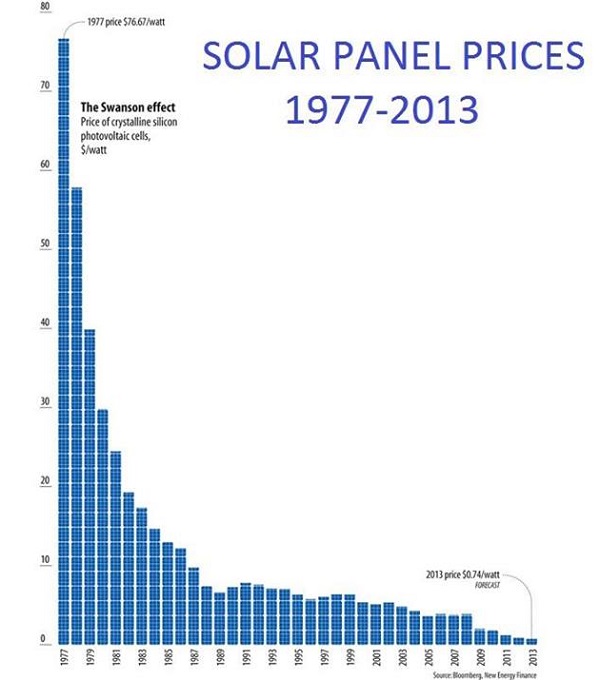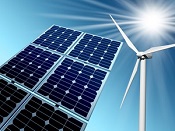As noted in Climate Clippings 139 (Item 5) the new Queensland Labor Government has committed to a 50% renewable energy target by 2030 so I was interested to attend a public forum last week on the future of electricity in Queensland, chaired by John Davidson as convenor of the West Brisbane Branch of the Queensland Greens. Speakers were John Foster, Professor of Economics at Queensland University, Murray Craig, Managing Director of Solar Centre and Charles Worringham, spokesperson for the Queensland Greens.
Targets or no targets, the emergence of solar is irresistible according to Prof Foster. He spoke of the Swanson effect, whereby the cost of solar panels drops by 20% for every doubling of sales. This is how the cost reduction of solar panels looks from 1977 to 2013:

Solar is now reaching grid parity with natural gas and should be lower than thermal coal by 2020. Australia and indeed Queensland has unrivalled solar potential. The widespread adoption of solar panels is about three years away, and cost-effective storage about four years away.
Queensland homes now have a million panels on 400,000 homes. The Queensland Government wants to lift the number of households with rooftop solar to one million by 2020.
At the next level up in terms of scale, a 3.25MW solar facility has been installed at the Gatton Campus of Queensland University. This type of installation will progressively become more common on shopping centres, perhaps schools and elsewhere where there is significant roof space. In terms of the connectivity of the panels this type of facility represents a step of in technical complexity. At present there is a skill deficit in this regard.
A further step in connectivity is the sharing of power through community grids, especially in small towns that are geographically somewhat isolated. Queensland has a significant number of these. Some will be utility-scale installations of several hundred megawatts.
As homes and shopping centre/community scale facilities proceed the cost of grids will be borne by a smaller base of customer power usage whether or not consumers take the step of disconnecting from the grid. Consumers taking the final step of going off-grid, if such is permitted, will need considerable storage capacity. Personally I believe too often when storage is spoken of the reality of a week or more of rain/cloud is ignored. Going off-grid requires considerable courage or an onsite backup system.
A feature of the current Queensland electricity system is an 86% reliance on coal, though according to this graph via RenewEconomy, not as much as Victoria and NSW:

The black bars represent black coal, brown for brown coal and red for gas.
The Queensland target of 50% by 2030 is not particularly ambitious when considered against, for example, the Greens policy of 90% by 2030, New Zealand’s target of 90% by 2025 and Canada’s target of 90% by 2020. The target has been adopted without any detail and perhaps any appreciation of the complexity of the task, the interests to be balanced and the laws to be changed. The new Queensland Productivity Commission will be asked to provide the necessary policy pathway.
Two factors make the transition easier. Firstly, Queensland, unique amongst the states has an increasing need for electricity in spite of the inroads made by PV solar. The coal seam gas industry is cranking up in a major way, and only one company is using the gas to power operations. The gas is compressed soon after leaving the well, so power is required on a decentralised basis. Then the gas is pumped via pipeline to Gladstone where it is liquefied, another power-hungry operation.
Secondly, Queensland still has the advantage of owning some of the power generation facilities, and all of the distribution through Energex (SE Queensland) and Ergon (regional Queensland).
Murray Craig reminded the audience that while PV solar had been popular, there was still vast scope for further installations. Even more so for solar hot water systems where the market penetration was as low as 10%. This is surprising because the costs of solar compared to electric hot water comes in at less than half when considered over 15 years. The problem would appear to be that 5 to 7 years is required for a net benefit, which is too long for many people.
Long term finance could spread the cost. Prof Foster reminded us that the invention of ‘hire purchase’ after the war was essential to the consumer revolution which brought such common items as refrigerators, washing machines and TV sets to the less well-off.
Of course there was much else in just over two hours of talking, but one final item of interest. Charles Worringham in delving into the finances of electricity distribution found that several hundreds of millions had been apportioned to the extension of the electricity grid, deep into the Surat Basin, presumably to power the coal seam gas industry. Indeed the line for “other projects” with just on $300 million against it looked suspiciously like laundering further support for the CSG industry. More transparency is required!
Obviously planning is vital, but the path is not untrodden. For example:
- Germany’s “renewable targets are on track, have lowered emissions, decoupled energy consumption from economic growth, pushed wholesale prices down to record lows, and are now pushing retail prices down”.


Brian: Thanks for producing this report on our electricity forum. I thought we did well but it needs an outsider to be more objective
John, as a forum you did better than my report can convey!
Thanks Brian that’s really interesting, and good work John. Here in Victoria we have just had the Grattan institute come out with another ambivalent report on solar ( they have a track record of doing this stuff), so it’s nice to read something positive.
Brian how often do you get those weeks of cloud, and does it really matter? I’m sure if our climate here was as warm as Queensland’s I could easily go off grid – it’s heating that’s the big problem. I have thought of getting a gas heater, but gas isn’t that much better really, and I feel like I’d be adding to the demand and encouraging fracking. Really efficient and pollution free wood heaters might be an answer, but does such a thing exist?
Val, for the Grattan Institute report see Climate clippings 140, Item 4.
My guess is that we’d get multiple days of cloud perhaps only 4 or 5 times a year, but, yes, it matters a lot, I think.
Val: Reverse cycle air conditioners and other devices based on heat pumps are the most efficient way of converting electricity into heat since one kWh will produce several kWh of heat. By contrast, a bar heater will produce only 1 kWh of heat per kWh and a gas heater will perform even worse. You can do even better if you have some form of heat storage because it takes less enrgy to pump a kWh of heat if it is done during the warmer part of the day.
On the subject of going off grid you will generate a lot of unused electricity and require a lot of storage unless you have a back-up generator or be prepared to go with very little power from time to time.
Val, the reason why it matters is that we are quite dependent on electricity and have just about zero tolerance of blackouts that last more than a few hours.
We put up with them from time to time here because of storms, but power is normally restored pretty quickly.